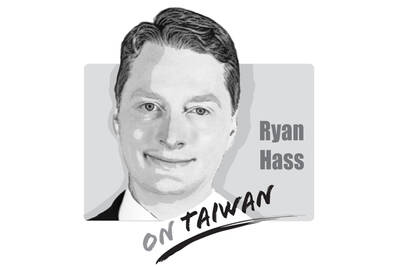From the general mood on Saturday, it was hard to imagine that the 100,000 people who protested in downtown Taipei were mobilizing against a policy that, as they interpret it, is a matter of life and death for themselves and — judging by the large number of babies and children — their descendants.
What with the laughter, gaudy costumes, soap bubbles, incessant picture-taking and lively songs, one would think one had chanced upon a festival of some sort, not a rally against an ill-understood form of energy that, in the wake of the nuclear incident at the Fukushima Dai-ichi power plant in Japan in March 2011, fuels people’s fears of the terrible consequences should a catastrophe occur at one of the nation’s three operational plants.
The same could be said about other, large protests held in recent months, such as those targeting the risks of monopolization of the nation’s media.
Festive mood notwithstanding, the issues that have catalyzed protesters are no laughing matter. If we factor in the several, smaller protests held over the past four years, it becomes clear that the general mood that has descended upon Taiwanese is far more somber.
Not a week passes nowadays without a public protest being held, with issues ranging from nuclear energy to laid-off workers, state-sanctioned land seizures to the risks of Chinese influence in the local media. The frequency of the protests alone is cause for worry, as it highlights a serious disconnect between the public and the government, and the latter’s inability, or unwillingness, to resolve the issues.
While the administration of President Ma Ying-jeou (馬英九) has largely succeeded over the years in weathering large-scale protests organized by the Democratic Progressive Party (DPP) and other parties in the pan-green camp, such as the “Fury” (火大) rally held earlier this year, other protests increasingly involve far more diverse groups of people and many more young people. Additionally, the new protesters have tended to dissociate themselves from the green camp, and on some issues, such as nuclear energy, many are (or were) Chinese Nationalist Party (KMT) supporters.
Consequently, while DPP rallies, however large, constituted for the Ma administration a relatively cost-free expression of discontent in terms of their impact on local and national elections, the great majority of protesters tended to be elderly and from the green camp, the KMT cannot afford to ignore the potential ramifications of the new wave of protests, as failure to address those grievances can directly translate into lost votes for the blue camp.
“I voted for the KMT last year, but I’m not sure I’ll vote for them again if they continue to ignore my voice,” was a common refrain on Saturday.
In many ways, the new protesters are not only sending a strong message of anger at the Ma administration; they are also clearly articulating the issues that matter to them and which the DPP, if it ever wants to recapture the Presidential Office, must pay attention to — not by cynically exploiting those for political gain, but by seriously providing viable alternatives that will have a real impact on people’s livelihoods.
The birthday party-like atmosphere might not last for much longer. That young people, long accused of being lethargic and uninterested in political issues, are now mobilizing, launching sit-ins and, at times, risking arrest, is a sign of a growing malaise within Taiwanese society. The longer the Ma administration continues to ignore their voices, the darker will the mood become.
So far, Taiwanese have been uncannily peaceful, and almost unnaturally patient with government officials, in their protests. That could change.

There are moments in history when America has turned its back on its principles and withdrawn from past commitments in service of higher goals. For example, US-Soviet Cold War competition compelled America to make a range of deals with unsavory and undemocratic figures across Latin America and Africa in service of geostrategic aims. The United States overlooked mass atrocities against the Bengali population in modern-day Bangladesh in the early 1970s in service of its tilt toward Pakistan, a relationship the Nixon administration deemed critical to its larger aims in developing relations with China. Then, of course, America switched diplomatic recognition
The international women’s soccer match between Taiwan and New Zealand at the Kaohsiung Nanzih Football Stadium, scheduled for Tuesday last week, was canceled at the last minute amid safety concerns over poor field conditions raised by the visiting team. The Football Ferns, as New Zealand’s women’s soccer team are known, had arrived in Taiwan one week earlier to prepare and soon raised their concerns. Efforts were made to improve the field, but the replacement patches of grass could not grow fast enough. The Football Ferns canceled the closed-door training match and then days later, the main event against Team Taiwan. The safety
The National Immigration Agency on Tuesday said it had notified some naturalized citizens from China that they still had to renounce their People’s Republic of China (PRC) citizenship. They must provide proof that they have canceled their household registration in China within three months of the receipt of the notice. If they do not, the agency said it would cancel their household registration in Taiwan. Chinese are required to give up their PRC citizenship and household registration to become Republic of China (ROC) nationals, Mainland Affairs Council Minister Chiu Chui-cheng (邱垂正) said. He was referring to Article 9-1 of the Act
The Chinese government on March 29 sent shock waves through the Tibetan Buddhist community by announcing the untimely death of one of its most revered spiritual figures, Hungkar Dorje Rinpoche. His sudden passing in Vietnam raised widespread suspicion and concern among his followers, who demanded an investigation. International human rights organization Human Rights Watch joined their call and urged a thorough investigation into his death, highlighting the potential involvement of the Chinese government. At just 56 years old, Rinpoche was influential not only as a spiritual leader, but also for his steadfast efforts to preserve and promote Tibetan identity and cultural